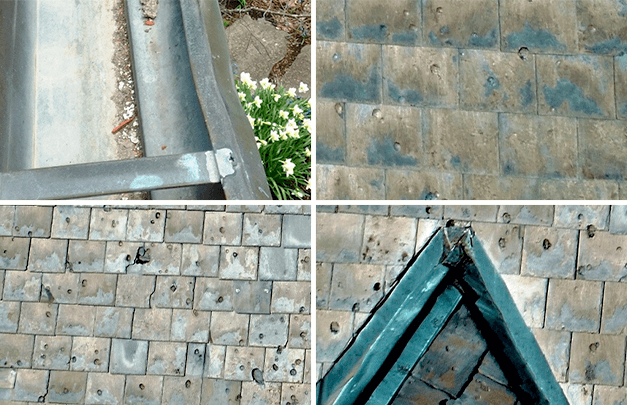.jpg?width=1024&height=768&name=DSCF8630%20(1).jpg)
Hail damage to a slate roof can be extremely detrimental to the overall structural and historical integrity of your entire roofing system. The trouble is that hail damage to a slate roof is not necessarily something you can spot from the ground, or something that is immediately visible to the naked eye. Many times, slate roofs will have “hidden” damage. Plus, hail damage can take many shapes and forms, and sometimes it’s the smallest indention, hole, crack, or break that, if unnoticed, can create the biggest and most expensive problems down the line.
With this in mind, let’s first look at the kinds of larger structural problems hail damage can cause, and then walk through important things to check in order to know if your slate roof has sustained hail damage.
what kind of problems can hail damage cause to a slate roof?
As with many complications from roof damage, the biggest potential problem with hail damage to a slate roof comes from water seeping through cracks or breaks in slate pieces. This is a problem for two reasons:
- First, water that leaks through holes or cracks in a slate roof will be absorbed by the components beneath, and that can degrade the strength and protection your roof provides.
- Second, and perhaps most important as we enter the cold winter months, water from rain or melting snow that does penetrate cracks in a slate roof will freeze and expand. This expansion can turn a small crack into a much larger one, and in some cases can completely break the piece of slate.
Plus, depending on where the damage to your slate roof occurs, you can also experience damage to other important parts of your roof, including the chimney flashing, chimney caps, and any decorative copper hip or ridge flashing elements, copper dormers, copper flat panel roofs, collector boxes, chimney covers, and more.
It’s important to remember that a roof is a connected system where damage or deterioration to one part can impact others, and this interconnectivity can complicate identifying where damage has occurred and how to address it.

what does hail damage to a slate roof look like?
just because you can’t see hail damage to your slate roof doesn’t mean damage has not occurred — and, as you’d imagine, the size and velocity of hailstones directly impacts the extent and severity of the damage.
the images above show original early 1900s-era Pennsylvania Slates that were dented by a hail storm in Evanston, Illinois. The storm involved larger hail pieces, many of which punched holes directly through the slate. The decorative copper ridge trim also sustained significant damage, including denting and bowing to the surface of this custom-fabricated ridge. What's more, the 16 oz. copper gutter system showed circular impact markings as well as visibly bent areas. Even the gutter hanger shows signs of hail damage.
How do I know if my slate roof has hail damage?
When evaluating whether your slate roof has in fact sustained hail damage, it’s important to look for the following signs:
- Large or small indentations in slabs of your slate roof. Hail damage to the corners or seams where more than one piece of slate connects or meets another is also important to identify soon after a hail storm, as gaps in junction points can allow for increased water or moisture penetration. Aside from dents, it’s also important to look for hail damage in the form of hairline cracks, fractures, or chips.
- Holes punched through pieces of your slate roof. Whereas a moderate hail storm can merely leave indentations in a piece of slate roofing, more intense or larger hail can actually punch holes through pieces, leaving your roof system susceptible to water penetration almost immediately.
- Damage to other roof components that either support or are supported by the slate portions. This can include damage to roofing elements such as copper valleys, flashing, decorative copper hips, ridge flashing, and a variety of chimney components including caps, covers, and flashing.
- Gutters. Yes, hail damage to gutters can also impact the performance and service life of your slate roof. Without proper drainage from an efficient gutter system, water can accumulate and even puddle or pool in certain spots of your slate roof.
While this checklist can help you get started on identifying whether your slate roof has sustained hail damage, it’s important to partner with roofing professionals that have the technology, craftsmanship, and proven track record of safe restoration practices to repair or restore your roof in a way that maintains its historical accuracy.
Our Magellan Building Assessment program can help homeowners identify if a roof has experienced hail damage, and our Monarch Elite Process creates a transparent, easy-to-understand project plan that will repair or replace damage to your slate roof with an eye toward historical integrity.
Contact us today to learn more about how our team of restoration specialists can help you identify and repair your hail damaged slate roof.
